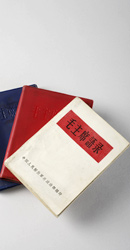Archive: Art, History, and Politics
 This section of the exhibition is devoted to an historical account of China from 1949, when the Communist Party assumed power and established The Peoples Republic of China, to 1979, two years after the end of the Cultural Revolution. The printed materials, objects from everyday life, and other ephemera attempt to document the political and artistic transformation—at times extreme and often violent—in Chinese society during this period. The materials provide a glimpse into the daily life and social history of this period.
This section of the exhibition is devoted to an historical account of China from 1949, when the Communist Party assumed power and established The Peoples Republic of China, to 1979, two years after the end of the Cultural Revolution. The printed materials, objects from everyday life, and other ephemera attempt to document the political and artistic transformation—at times extreme and often violent—in Chinese society during this period. The materials provide a glimpse into the daily life and social history of this period.
During this period, revolutionary images and images of Mao were printed on all manner of objects. Mao icons filtered into homes and factories and permeated all aspects of daily life. Reproductions of the painting Chairman Mao Goes to Anyuan were printed on posters and kitchenware, and the painting acted as inspiration for statues. Mao badges were avidly collected by Red Guards. In 1967, the monthly production of Mao badges rose to six million. Objects that were not consistent with the socialist doctrine were dismissed as decadent remnants of a bourgeois past and were often destroyed.
New operas and plays were commissioned to show the perils of feudalism and to justify revolution. The choreographed movements of young, healthy workers, peasants, and soldiers in these performances were a metaphor for the strength and prosperity of the new nation and the success of the revolution. In contrast to the strict delineation between the literati and commercial arts that was characteristic of Chinas past, this period saw a break-down in the distinctions between so called high and low art.
1 | 2 | 3 | 4 | 5
Intro | Mao | To Rebel | Never Forget | Up to the Mountains | Archive | Long March
